Our two big Andean adventures (Paso Sico and the remote Southwest Bolivia ride) left me with more than some nice photos and a few good tales to tell.
Those cold hard rides had gifted me something that felt like the early stages of pneumonia.
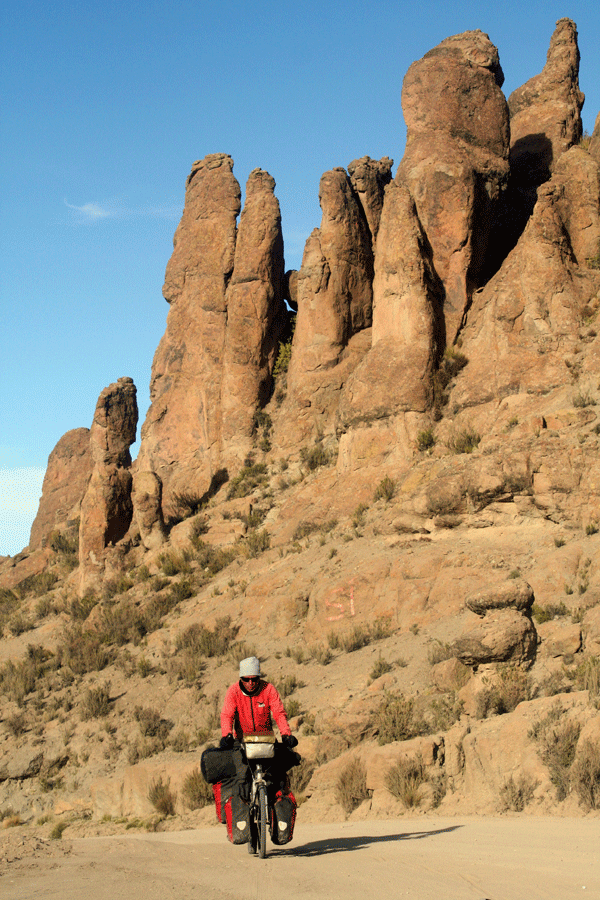
I was the sickly one in room 42 at Uyuni’s Hotel Avenida. The one who coughed and hacked all night, keeping those in adjoining rooms awake. The one who rasped and wheezed, whose sneezing ended with a shudder and shaking, a few sniffles and finally a, “thanks, I’m fine,–really–feeling better every day,” addressed to anyone showing sympathy.
And there were plenty of sympathy givers. Hotel Avenida was full of tourists, all on their way to or from the famous Salar.
The largest salt flats in the world, stretching some 120 kilometers across the otherwise barren land. Cycling across the great white expanse of the Salar is a highlight for any South American bicycle tourist.
And now the Salar was flooded. Buried under 10 centimeters of water.
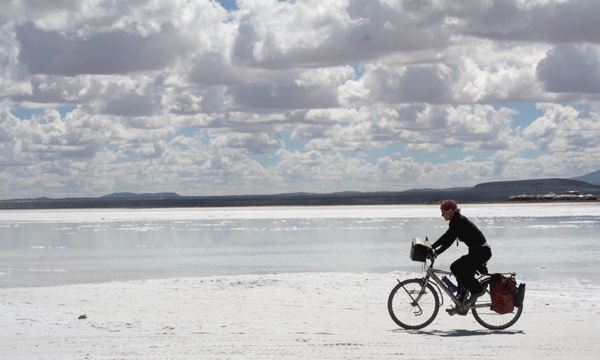
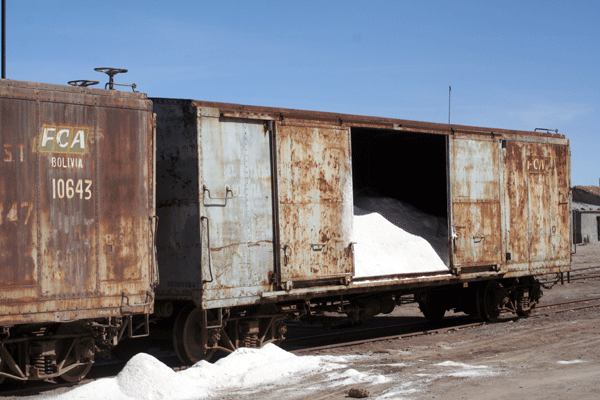
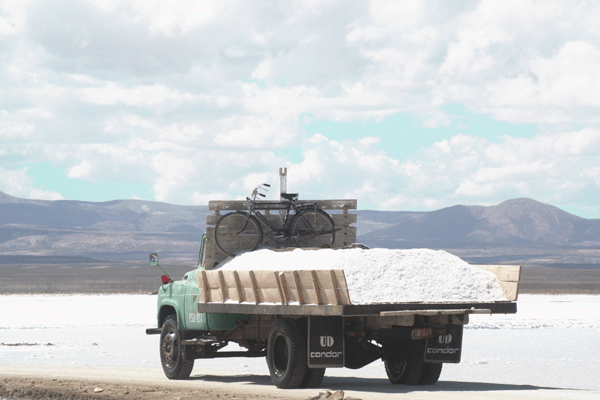
Not that I was really up for another adventure.
It was time to lay low, get well.
Wandering around Uyuni’s markets was all I was really up to.
Observing the buying and selling of goods is an age-old pastime of tourists everywhere from Bangkok to Beirut, Marrakesh to Mumbai. Bolivia is one of the better countries to partake in this simple pleasure.
First, there are the vegetable markets where huge women in wide pleated skirts and frilly aprons preside over mounds of avocadoes and potatoes, pyramids of bright purple onions and tiny bouquets of parsley.
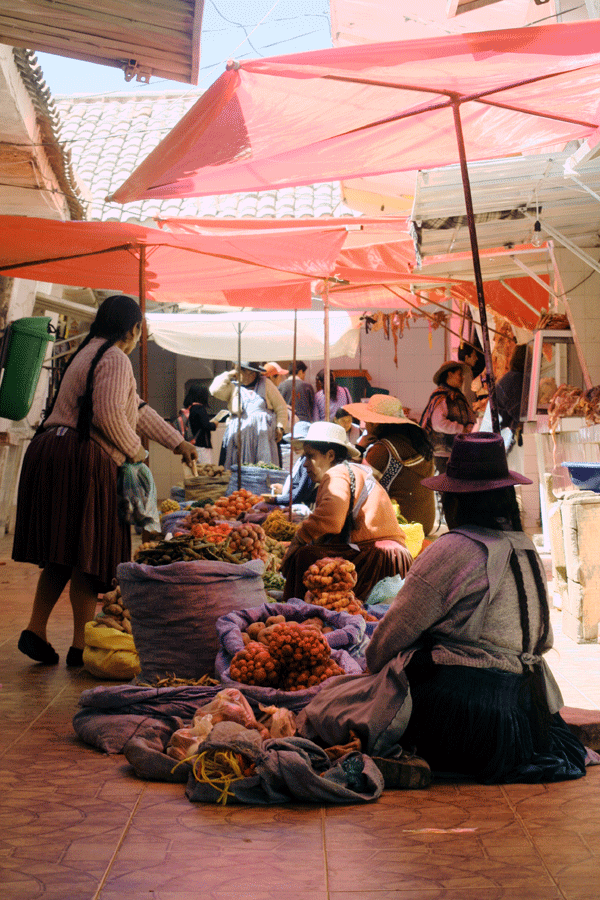
Then there’s the meat market, best avoided by those with queasy stomachs. Bolivians, unlike Europeans and Americans, see no need to be disconnected from the fact that they’re purchasing, and will soon consume, a dead animal.
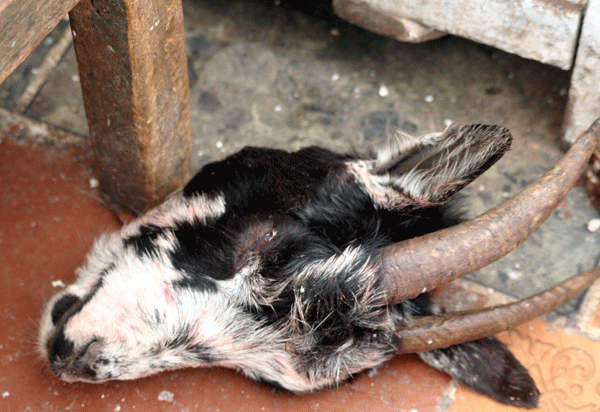
No, Bolivian’s seem to revel in the fact that what they’re about to buy a piece of flesh which was, just hours ago, out grazing in an open field. The head and hooves of the recently slaughtered animals are proudly displayed next to the fly-covered meat on offer.
No, you really don’t want to wander into the meat section.
The streets are overflowing with people displaying their wares. The lucky ones spread out their pirated CD’s, batteries and various trinkets on tables. Those less fortunate grab a piece of the pavement and squat before a few forlorn sacks of flour or a handful of tiny vials whose contents promise to cure everything from hemorrhoids to impotence.
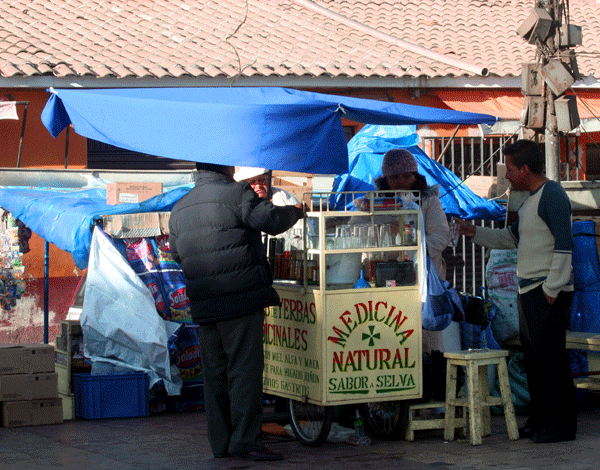
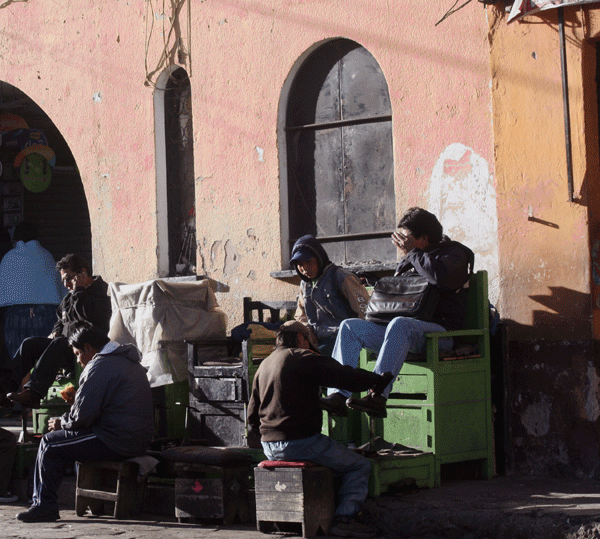
I head to the mounds of used clothing known across the continent as Ropa Americana. After much rummaging through cast-offs from the Salvation Army and the Goodwill Shop, I decide on a powder blue fleece jacket from the Gap and a long-sleeved Esprit top sporting the slogan ‘I love music, dance and fun.’ This piece of clothing was quite obviously not marketed to my age group, but it’s in good condition and looks warm. My purchases set me back just 20 Bolivianos (about $3).
As I trudge back to the hotel, past the sellers of cheap (albeit new) clothing imported directly from China, I note how few buyers there are.
At the small central plaza, a few enterprising individuals have set up outdoor bars and cafes catering to the tourist crowd. Backpacker types huddle together under the strong sun, some thumbing through the Lonely Planet, others laughing loudly, surely recounting tales from their adventures on the road, roughing it on the Southwest Bolivia tourist circuit or maybe a story of late-night revelry.
They look happy and I am hit with a sudden pang of jealousy.
Cycling can be lonely. We spend most of our time on the road, sleeping in small, nameless villages or under the wide open sky. Apart from other cyclists, there are few who understand our solitary journeys and self-enforced suffering.
A few days of rest and I’m feeling better. Or maybe boredom is getting the best of me. Apart from meandering through the market, there’s not much in Uyuni to hold anyone’s interest. It’s really just a cold, dusty railway town on the edge of the Salar. Even the internet is hardly a viable escape, seeing as the connection is so pitiful you can peruse a couple of pages in the guidebook before the browser opens up a new page.
Word has it that the road to Potosí is paved. Yippee! We’re fed up with sand and washboarding and feeling proud when we’re able to crank out 50 kilometers in a day. Bring on the asphalt, I say.
Turns out “paved all the way to Potosí” isn’t quite right. Paved most of the way. As in, the easy parts are paved. The steep, narrow winding parts, that is to say when you really need, want and desire asphalt, those parts are in their, shall we say, natural state.
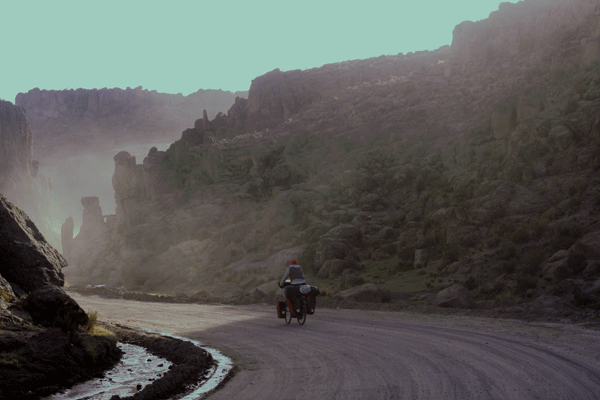
The road out of Uyuni goes straight up, at a sometimes unforgivingly steep slope. Oh how I wished I was back wandering those markets instead of forcing my weary legs to pedal a 55 kilo loaded bicycle up a mountainside.
Then we hit top at the tiny mining village of Pulacayo perched up high at over 4,000 meters. Ahead lay the asphalt. I let out a whoop of delight and raced downward. Practically all afternoon the gentle descent continued until we landed at the village of Ticatica. Really nothing more than a kink in the road, there were a few shops catering to the long-distance bus traffic and a simple guesthouse.
The owner is asking 40 Bolivianos (about $6), which (according to Eric) is outlandish for such basic lodging. The alojamiento is a mud-brick structure with an outhouse out back. There isn’t even a door for the pit toilet, just a couple of old rice sacks taped together to provide a bit of privacy. A shower is out of the question and the town is experiencing a water cut, so for cooking and washing up we’ll have to use the water stored in the old 2-liter Coke bottles lining the building.
Finally, we agree on 20 Bolivianos. The room is surprisingly clean, even cosy. Someone had gone to the trouble of tacking up a few kitschy posters, one of Machu Pichu, another of some overly cute pets and a third portraying some random beautiful countryside scenery.
In the morning, when I comment to the señora in charge how much we appreciated the cleanliness of the establishment, her palm is immediately upturned and she’s requesting more money.
Eric chuckles and forks over another 4 Bolivianos. The señora’s face lights up and she waves us off with a cheery, “Que les vayan bien” and “Buen Viaje.” Take care and have a nice trip.
The trip begins–not so nicely–with another steep climb. Naturally, this stretch is not paved. Up, up, up all the way to around 4,200 meters and then down, and then up again.
We ought to be getting used to this by now. But honestly, I feel cheated and tricked. This is, after all, supposed to be the ALTIPLANO. High Plains. Plateau. Flatlands. I didn’t sign on for the never-ending tortuous climbs. There’s a fine line between a good challenge (which is fun) and gratuitous suffering (which just sucks).
That evening we arrive in a charming village by the name of Chaquilla. The village lies in a fertile valley surrounded by fields of quinoa and potatoes. Herds of domestic llamas with their brightly colored tassels graze nearby, and there’s even a tiny plaza on which sits the eloquently named Tourist Hotel.
Eric is suspicious, firmly believing that any establishment using the word ‘tourist’ in its name is synonymous with rip-off.
We knock politely, call-out, clap loudly and finally resort to banging on the guesthouse door. It’s Good Friday and nobody is about.
The old woman manning the corner shop tries to explain something in Quechua and broken Spanish. From her gestures I gather there’s another guesthouse further on. We continue, but no, the village comes to an abrupt end.
We return to the shop, and there are a few more muddled attempts at conversation until finally a fancy 4×4 pulls up. The old lady speaks to the driver in Quechua, and he then translates to us in Spanish.
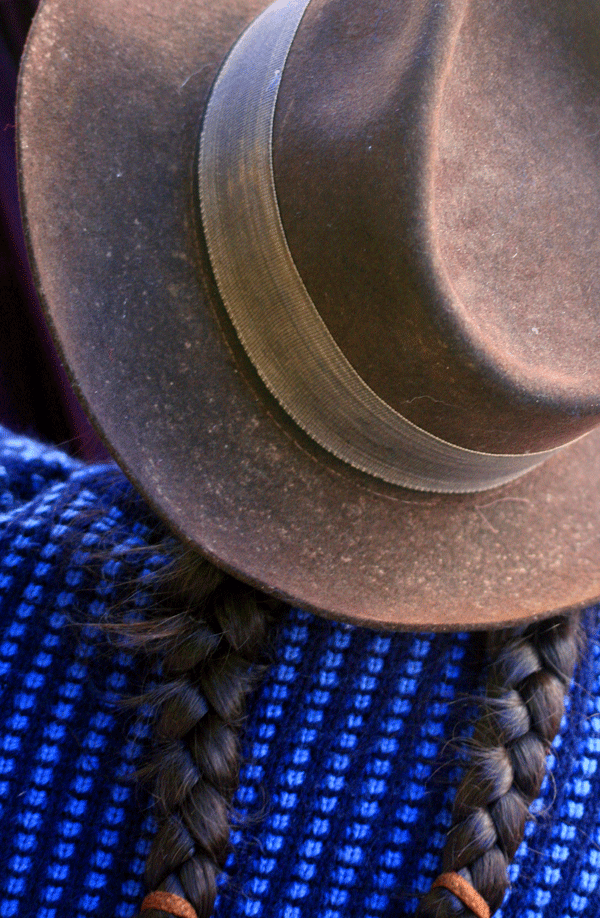
Apparently, the family running the hotel has gone on a trip and they will be back ‘mas tarde,’– later. When later, I ask.
‘Mas tarde,’ insists our translator. Later. Just later.
Now you’re probably thinking, you’ve got a tent, why not use it?
Because it’s cold. And I hate the cold. I left Montana some 20 years ago to escape the cold. And well, maybe Bolivia isn’t the safest place in the world to be camping out in the middle of nowhere. There is the occasional tale of a hapless cyclist being robbed in the night.
We run through the usual list of hospitality prospects:
School? Closed.
Church? Only open on Sundays when the itinerant priest passes.
Municipal buildings? Locked up tight for the holiday.
Random friendly individual? Negative.
Health Center? Bingo.
Abundio, the auxliliary health worker in charge, invites us in to pitch our tent in the courtyard. As he scrubs and beats his laundry in an endless stream of ice-cold water, we get to chatting. Abundio tells us his home and family are in Potosí, he sees them just four days a month. This has been going on since he began his work at the village health center some 13 years ago. His children are now at university, one is studying to be a doctor, and I can tell Abundio is proud and doesn’t regret his sacrifices.
Abundio wrings out his now lilly white socks and underwear and I reflect on his dedication not only to his family, but to the act of getting clothes clean. I’m a pretty lazy laundress, just swishing about a bit of powdered soap, rarely getting down to the dirty work of scrubbing and beating till the clothes are sparkling clean.
We set off the following morning at 6:15 AM Bolivian time. I say Bolivian time, because our watches are set one hour earlier. It’s a psychological thing. We need to get up early, but if I see it’s only 5AM, freezing cold and pitch black outside, there’s no way I’m rolling out of the tent.
6 AM feels far more realistic. We know it’s only 5AM, but the watch says 6AM, so yes, we manage to struggle out of the sleeping bags, make coffee, cook up a pot of porridge, pack up the tent and eventually hit the road just after the sun’s first rays begin to warm us.
It will be a tough day, with three big climbs to over 4,000 meters. I’m prepared with good music and oreo cookies. Just before 5:00 PM, we finally spot Potosí and Cerro Rico, the big hill out of which so much of the world’s silver was once dug.
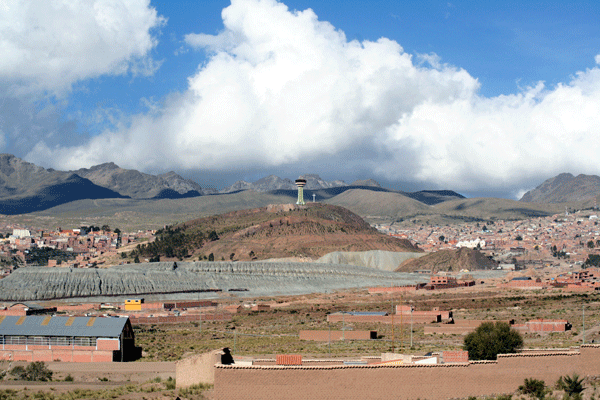
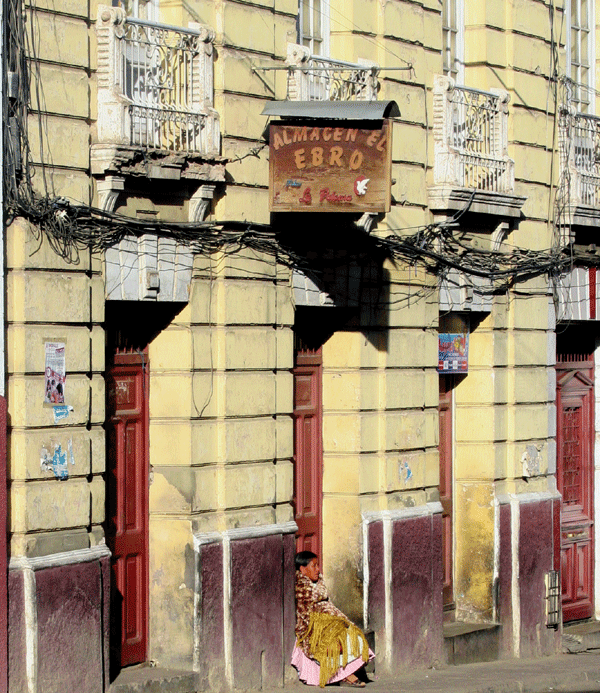
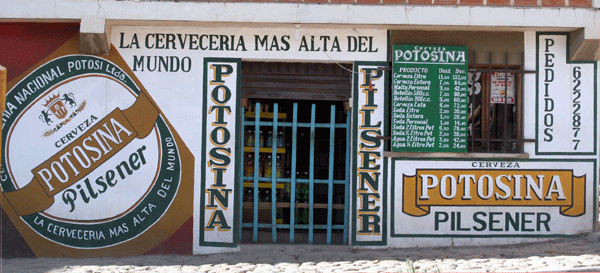
The city is a maze of markets and steep, winding streets. My legs go feeble just at the thought of more climbing.
We gain at least another 300 meters of altitude before finally stumbling into Alojamiento La Paz, the same crumbling guesthouse where we stayed on our first visit to Potosí back in 2002.
Just three days have passed since we left Uyuni, but I feel as if we’ve been on the road non-stop for three weeks.
Cycling the Andes is real work, many times each day we cross the line between adventure and gratuitous suffering. I’m not ready to hop on a bus yet, but, damn wouldn’t I like a few days of flat roads, warm weather and sickness-free cycling.


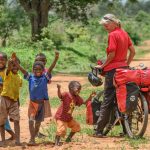
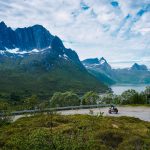
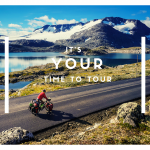
I feel like I am sitting comfortably on your shoulder, catching glimpses of parts of the world I hope to see. I love your honesty is telling us the difficulties of your journey, the questioning of your resolve and in the end, your relentless pursuit of the road. I am with you in spirit, cheering you on while you are climbing that endless, washboard road. Can’t wait to hear more! Best to you and Eric. Peg
Thanks Peg, so nice to know somebody is cheering us on during tough times. Hope to catch up with you again when we cycle north.
Oh my, what a journey….What real bikers will endure in the name of two wheels travel. You are right…under these high elevation, cold and arid conditions take a rest day every few days…..We want you to get to the easy roads….if there is such a thing with international bike touring. We have got to see you and hear your story when you reach Oregon. Ride safe, Ed
Eric and Amaya, Just questions…….What do the Altiplano folks use for fuel….coal? gas? Surely not wood…..Oil? Such a high cool high elevation place must take heat year around…especially summer nights….Ed
Altiplano folks are not so lucky as to have heating in their homes. People just have to put up with the cold nights, wear warm clothing and cover up with lots of blankets. The sun being so strong, daytime temperatures are bearable, even pleasant like a warm spring day at lower altitudes sucha as in Sucre (2,800 meters).
Great article – it helped with my research. 🙂
I poked my head into a hut in the Peruvian Andes to see nothing but a pile of dried animal dung. That’s what they use for cooking in the places where there is nothing else flammable around – seriously. It burns well and doesn’t smell. Any type of indoor heating has been non-existent since I got into the Andes in Colombia, but if you’re lucky, there will be butane heated water in some of the hotels.
Enjoy the hills between Cuzco and Ayacucho. 😀
Paul